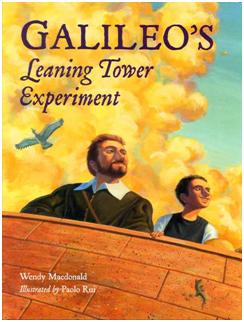 Galileo Galilei is one of the key figures in the history of science. One of his most famous exploits occurred when he was a young man of 26 at the very beginning of his career. In 1589, he had just been appointed as a Professor at the University of Pisa. Refusing to take Aristotle’s word as final on the behavior of falling bodies, Galileo climbed the Leaning Tower of Pisa (actually the bell tower for the cathedral) and dropped various objects of different sizes and weights to test the idea that all bodies fall at the same rate. As it turned out, Aristotle was wrong – a fact which Galileo almost certainly knew before he conducted his very public demonstration.
Galileo Galilei is one of the key figures in the history of science. One of his most famous exploits occurred when he was a young man of 26 at the very beginning of his career. In 1589, he had just been appointed as a Professor at the University of Pisa. Refusing to take Aristotle’s word as final on the behavior of falling bodies, Galileo climbed the Leaning Tower of Pisa (actually the bell tower for the cathedral) and dropped various objects of different sizes and weights to test the idea that all bodies fall at the same rate. As it turned out, Aristotle was wrong – a fact which Galileo almost certainly knew before he conducted his very public demonstration.
This is a delightful children’s book by Wendy Macdonald of Australia and illustrated by Paolo Rui of Milan, Italy. It tells the story of Galileo’s famous experiment and makes the story accessible to children by introducing the character of Massimo, who looks to be about eight or nine. Galileo meets Massimo as he crosses the bridge where Massimo has been stationed with a mission to drop food onto the boat owned by his uncle as it passes underneath. Galileo stops to chat with the boy. He is intrigued as he observes that a heavy wheel of cheese and a much lighter loaf of bread land on the deck of the boat passing beneath the bridge at the same time. Massimo is surprised to discover that the young man talking to him is a professor at the University.
Watching Massimo drop food to his uncle from the bridge leads Galileo to begin questioning Aristotle, who stated that heavier things fell faster than lighter things. Massimo thinks about what Galileo has said and conducts his own experiments from the roof of his family’s farmhouse. This leads to a visit by Massimo to Galileo’s offices at the university. From there, it is only logical that Massimo will be Galileo’s assistant when he stages his very public demonstration from the top of the “Leaning Tower.”
Massimo is fictional, but Galileo’s observations and experiment from the top of the Tower are well-documented. The publisher lists this book’s target audience as children, ages 4 to 8. The text could certainly be read to younger children, but I think the history and science involved will be of interest to students through upper elementary and age 10-12.
The illustrations capture the feel of late Renaissance / early modern Italy and the excitement and optimism of the young Galileo as he studies the natural world directly and challenges Aristotle. It was a very important moment in the history of science – and a worthwhile story told in a very entertaining way.
Galileo’s Leaning Tower Experiment is 32 pages, available as a hardback for $16.95 or as a paperback for $7.95 directly from Greenleaf Press.
Highly recommended for your study of the Renaissance, the Age of Explorers, or to go along with Famous Men of the 16th & 17th Century (which has a chapter on Galileo).
– Rob Shearer, Publisher
